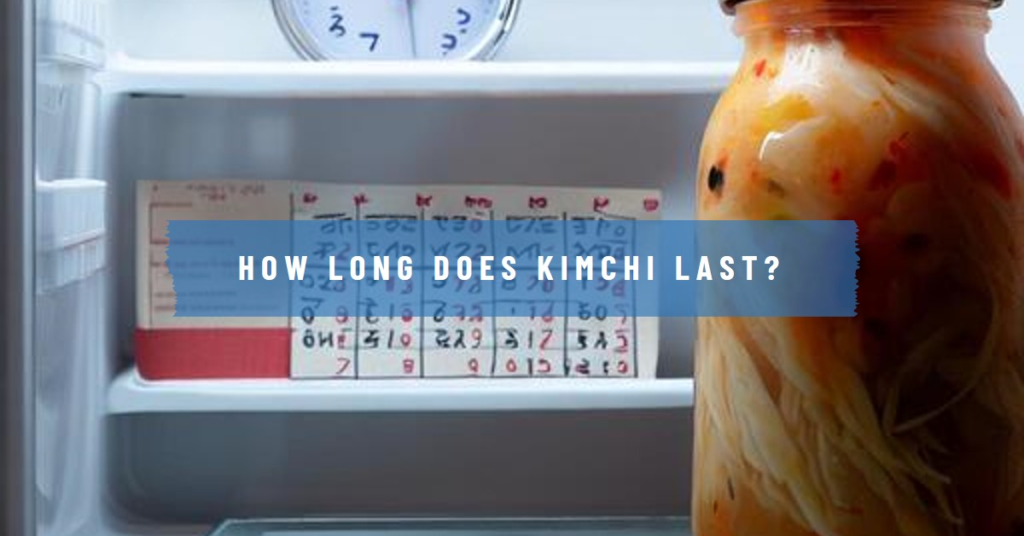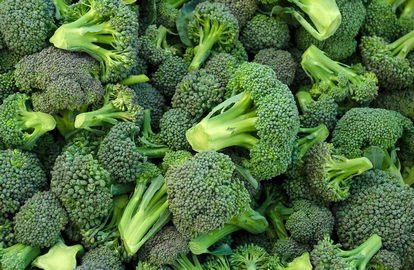A QUICK GLANCE…
Kimchi, a traditional Korean dish made from fermented vegetables, can last for a significant amount of time due to its fermentation process. If properly stored in an airtight container and kept in the refrigerator, a freshly made batch of kimchi can remain edible for up to 1 to 3 months. However, it’s worth noting that the flavor and texture of the kimchi will change over time. It will become more sour and its texture more soft as the fermentation continues. Although it’s technically safe to consume for longer periods, it’s generally recommended to consume kimchi within the 1 to 3 month timeframe for the best quality and taste.

Have you ever found yourself with a jar of kimchi in your fridge for what seems like ages? Maybe you’re not sure if it’s still good to eat or if it’s time to toss it out.
As avid kimchi lovers ourselves, we can relate to the struggle of trying to determine how long kimchi lasts. In this article, we’ll explore the various factors that affect kimchi’s shelf life, as well as share tips on how to store it properly to extend its freshness.
We’ll also discuss the telltale signs of spoilage to look out for and give you some creative ideas for using up any leftover kimchi you may have. So, let’s dive in and explore the world of kimchi shelf life!
Factors Affecting Kimchi’s Shelf Life
Now, let’s talk about what affects how much time you’ve got until your delicious jar of fermented goodness turns sour and funky.
The fermentation process is the main factor that determines the shelf life of kimchi. As kimchi ferments, the lactic acid bacteria present in the ingredients consume the sugars in the cabbage and radish, releasing carbon dioxide and acidifying the environment. This is what gives kimchi its tangy flavor and preserves it. However, if the fermentation process continues for too long, the kimchi can become too sour and spoil.
Another factor that affects how long kimchi lasts is the preservatives used in the recipe. Some traditional kimchi recipes call for salted shrimp, fish sauce, or other seafood-based ingredients that can act as natural preservatives. These ingredients can help to extend the shelf life of the kimchi by inhibiting the growth of harmful bacteria. However, if you’re making vegan or vegetarian kimchi, you may need to add other preservatives, such as vinegar or citric acid, to prevent spoilage.
It’s important to note that the temperature and storage conditions of your kimchi can also affect how long it lasts.
To keep your kimchi fresh for as long as possible, store it in the refrigerator at a temperature between 34 and 38 degrees Fahrenheit. This will slow down the fermentation process and help to preserve the flavors and texture of the kimchi. Additionally, make sure to keep the jar tightly sealed to prevent air from getting in and causing spoilage.
Storing Kimchi Properly
Properly storing your kimchi can ensure it stays fresh for an extended period of time. One way to do this is by vacuum sealing your kimchi. This process removes all the air from the container, preventing the growth of bacteria that could spoil your kimchi.
When vacuum sealing, make sure to leave enough space for the fermentation process to continue. This will allow the kimchi to ferment further and develop its unique sour and spicy flavor.
Another way to store your kimchi is by keeping it in an airtight container. Make sure to use a container that is large enough to hold your kimchi without pressing down on it. Pressing down on the kimchi can cause it to lose its texture and flavor.
Keep the container in the refrigerator, as this will slow down the fermentation process and prolong the shelf life of your kimchi.
Lastly, make sure to keep your kimchi away from direct sunlight and heat. Exposure to heat and light can cause the fermentation process to speed up, causing your kimchi to spoil quickly. Keeping your kimchi in a cool and dark place will help it last longer.
By following these simple steps, you can enjoy your homemade or store-bought kimchi for weeks or even months.
Signs of Spoilage to Look Out For
If your kimchi has a foul smell, slimy texture, or mold growing on it, it may have gone bad and should be discarded. Kimchi that has lost its tanginess or has become too sour is also a sign of spoilage. Unfortunately, there are no ways to revive spoiled kimchi. Once it’s gone bad, it’s no longer safe to eat.
To avoid having to throw away spoiled kimchi, it’s important to store it properly. Additionally, using it up in recipes before it goes bad can be a great way to reduce waste.
Here are some signs of spoilage to look out for when checking on your kimchi:
- Foul smell
- Slimy texture
- Mold growth
- Loss of tanginess or too sour taste
If you notice any of these signs, it’s best to discard the kimchi to avoid any potential health risks. However, if the kimchi has just lost some of its tanginess, there are still some recipes that can make use of it.
Kimchi fried rice, kimchi stew, and kimchi pancakes are some of the best recipes to use up old kimchi.
In summary, it’s important to be aware of the signs of spoilage when it comes to kimchi. Proper storage and utilizing it before it goes bad can help reduce waste. And while there are no ways to revive spoiled kimchi, there are still some tasty recipes to make use of kimchi that has just lost some of its tanginess.
Tips for Extending Kimchi’s Shelf Life
Want to keep your kimchi fresher for longer? Try these simple tips that will help you avoid having to throw out spoiled kimchi. Kimchi preservation is key to preserving kimchi freshness, and there are a few things you can do to extend its shelf life. Here are some tips on how to keep your kimchi fresh for as long as possible:
First, store your kimchi properly. This means keeping it in an airtight container in the refrigerator. The cooler temperature will slow down the fermentation process, which in turn will help to keep your kimchi fresh for longer. You can also add a layer of plastic wrap directly on top of the kimchi before sealing the container to prevent air from getting in.
Second, keep an eye on your kimchi. Check it regularly to make sure it hasn’t gone bad. To help you know when your kimchi is still good to eat, here’s a helpful table:
| Kimchi Color | Kimchi Status |
|---|---|
| Bright red | Fresh |
| Pink to orange | Starting to ferment |
| Light brown | Fully fermented |
| Dark brown | Overripe |
Lastly, use clean utensils when handling your kimchi. Any contamination can cause unwanted bacteria to grow, which can spoil your kimchi faster. By following these simple tips, you can extend the shelf life of your kimchi and enjoy it for longer.
Creative Uses for Leftover Kimchi
Get creative with your leftover kimchi and add some excitement to your meals by trying out these unique and delicious ideas! Don’t let your leftover kimchi go to waste – there are so many ways to incorporate its bold flavors into your meals.
Here are some ideas to get you started:
- Kimchi Fried Rice: Add some leftover kimchi to your fried rice for a spicy twist on a classic dish. Pair with some protein and veggies for a complete meal.
- Kimchi Grilled Cheese: Take your grilled cheese to the next level by adding a layer of kimchi. The tangy and spicy flavors pair perfectly with melted cheese and crispy bread.
- Kimchi Quesadilla: Use kimchi as a filling for your quesadilla for a fusion twist on a Mexican favorite. Add some shredded chicken or beef for extra protein.
Kimchi recipes and flavor pairings are endless. Don’t be afraid to experiment and try new things with your leftover kimchi. You might just discover a new favorite dish.
Leftover kimchi doesn’t have to be boring or go to waste. With a little creativity, you can turn it into a delicious and exciting addition to your meals. So next time you have some leftover kimchi, try out one of these ideas or come up with your own.
Your taste buds will thank you!
Conclusion
In conclusion, knowing how long kimchi lasts and how to properly store it is crucial for enjoying this delicious and nutritious food.
Various factors such as ingredients, fermentation time, and storage conditions can affect its shelf life. To extend its lifespan, it’s essential to keep it in an airtight container in the fridge and consume it within a reasonable time.
However, if you notice any signs of spoilage, such as a sour or off smell, slimy texture, or discoloration, it’s better to discard it.
Finally, don’t forget that leftover kimchi can be used in many creative ways, such as adding it to rice, noodles, soups, or sandwiches, or even making kimchi pancakes or fried rice.
By following these tips, you can enjoy a flavorful and healthy food that can last for a reasonable time.





